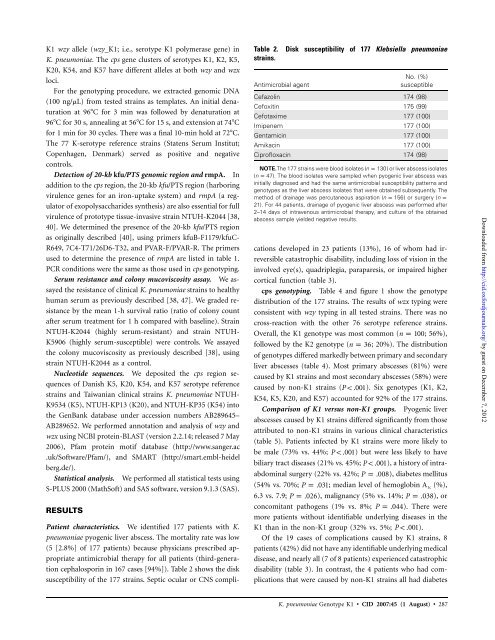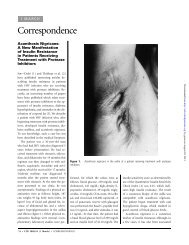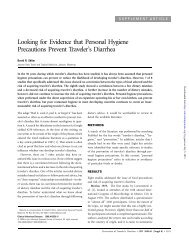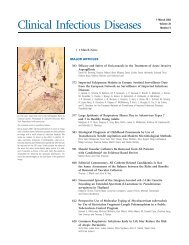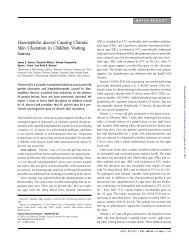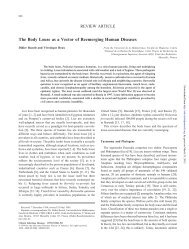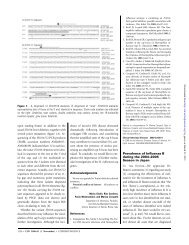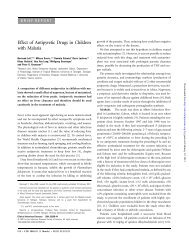Klebsiella pneumoniae - Clinical Infectious Diseases
Klebsiella pneumoniae - Clinical Infectious Diseases
Klebsiella pneumoniae - Clinical Infectious Diseases
You also want an ePaper? Increase the reach of your titles
YUMPU automatically turns print PDFs into web optimized ePapers that Google loves.
K1 wzy allele (wzy_K1; i.e., serotype K1 polymerase gene) in<br />
K. <strong>pneumoniae</strong>. The cps gene clusters of serotypes K1, K2, K5,<br />
K20, K54, and K57 have different alleles at both wzy and wzx<br />
loci.<br />
For the genotyping procedure, we extracted genomic DNA<br />
(100 ng/mL) from tested strains as templates. An initial denaturation<br />
at 96�C for 3 min was followed by denaturation at<br />
96�C for 30 s, annealing at 56�C for 15 s, and extension at 74�C<br />
for 1 min for 30 cycles. There was a final 10-min hold at 72�C.<br />
The 77 K-serotype reference strains (Statens Serum Institut;<br />
Copenhagen, Denmark) served as positive and negative<br />
controls.<br />
Detection of 20-kb kfu/PTS genomic region and rmpA. In<br />
addition to the cps region, the 20-kb kfu/PTS region (harboring<br />
virulence genes for an iron-uptake system) and rmpA (a regulator<br />
of exopolysaccharides synthesis) are also essential for full<br />
virulence of prototype tissue-invasive strain NTUH-K2044 [38,<br />
40]. We determined the presence of the 20-kb kfu/PTS region<br />
as originally described [40], using primers kfuB-F1179/kfuC-<br />
R649, 7C4-T71/26D6-T32, and PVAR-F/PVAR-R. The primers<br />
used to determine the presence of rmpA are listed in table 1.<br />
PCR conditions were the same as those used in cps genotyping.<br />
Serum resistance and colony mucoviscosity assay. We assayed<br />
the resistance of clinical K. <strong>pneumoniae</strong> strains to healthy<br />
human serum as previously described [38, 47]. We graded resistance<br />
by the mean 1-h survival ratio (ratio of colony count<br />
after serum treatment for 1 h compared with baseline). Strain<br />
NTUH-K2044 (highly serum-resistant) and strain NTUH-<br />
K5906 (highly serum-susceptible) were controls. We assayed<br />
the colony mucoviscosity as previously described [38], using<br />
strain NTUH-K2044 as a control.<br />
Nucleotide sequences. We deposited the cps region sequences<br />
of Danish K5, K20, K54, and K57 serotype reference<br />
strains and Taiwanian clinical strains K. <strong>pneumoniae</strong> NTUH-<br />
K9534 (K5), NTUH-KP13 (K20), and NTUH-KP35 (K54) into<br />
the GenBank database under accession numbers AB289645–<br />
AB289652. We performed annotation and analysis of wzy and<br />
wzx using NCBI protein-BLAST (version 2.2.14; released 7 May<br />
2006), Pfam protein motif database (http://www.sanger.ac<br />
.uk/Software/Pfam/), and SMART (http://smart.embl-heidel<br />
berg.de/).<br />
Statistical analysis. We performed all statistical tests using<br />
S-PLUS 2000 (MathSoft) and SAS software, version 9.1.3 (SAS).<br />
RESULTS<br />
Patient characteristics. We identified 177 patients with K.<br />
<strong>pneumoniae</strong> pyogenic liver abscess. The mortality rate was low<br />
(5 [2.8%] of 177 patients) because physicians prescribed appropriate<br />
antimicrobial therapy for all patients (third-generation<br />
cephalosporin in 167 cases [94%]). Table 2 shows the disk<br />
susceptibility of the 177 strains. Septic ocular or CNS compli-<br />
Table 2. Disk susceptibility of 177 <strong>Klebsiella</strong> <strong>pneumoniae</strong><br />
strains.<br />
Antimicrobial agent<br />
No. (%)<br />
susceptible<br />
Cefazolin 174 (98)<br />
Cefoxitin 175 (99)<br />
Cefotaxime 177 (100)<br />
Imipenem 177 (100)<br />
Gentamicin 177 (100)<br />
Amikacin 177 (100)<br />
Ciprofloxacin 174 (98)<br />
NOTE.The 177 strains were blood isolates ( n p 130)<br />
or liver abscess isolates<br />
( n p 47).<br />
The blood isolates were sampled when pyogenic liver abscess was<br />
initially diagnosed and had the same antimicrobial susceptibility patterns and<br />
genotypes as the liver abscess isolates that were obtained subsequently. The<br />
method of drainage was percutaneous aspiration ( n p 156) or surgery ( n p<br />
21).<br />
For 44 patients, drainage of pyogenic liver abscess was performed after<br />
2–14 days of intravenous antimicrobial therapy, and culture of the obtained<br />
abscess sample yielded negative results.<br />
cations developed in 23 patients (13%), 16 of whom had irreversible<br />
catastrophic disability, including loss of vision in the<br />
involved eye(s), quadriplegia, paraparesis, or impaired higher<br />
cortical function (table 3).<br />
cps genotyping. Table 4 and figure 1 show the genotype<br />
distribution of the 177 strains. The results of wzx typing were<br />
consistent with wzy typing in all tested strains. There was no<br />
cross-reaction with the other 76 serotype reference strains.<br />
Overall, the K1 genotype was most common ( n p 100;<br />
56%),<br />
followed by the K2 genotype ( n p 36;<br />
20%). The distribution<br />
of genotypes differed markedly between primary and secondary<br />
liver abscesses (table 4). Most primary abscesses (81%) were<br />
caused by K1 strains and most secondary abscesses (58%) were<br />
caused by non-K1 strains ( P ! .001).<br />
Six genotypes (K1, K2,<br />
K54, K5, K20, and K57) accounted for 92% of the 177 strains.<br />
Comparison of K1 versus non-K1 groups. Pyogenic liver<br />
abscesses caused by K1 strains differed significantly from those<br />
attributed to non-K1 strains in various clinical characteristics<br />
(table 5). Patients infected by K1 strains were more likely to<br />
be male (73% vs. 44%; P ! .001)<br />
but were less likely to have<br />
biliary tract diseases (21% vs. 45%; P ! .001),<br />
a history of intraabdominal<br />
surgery (22% vs. 42%; P p .008),<br />
diabetes mellitus<br />
(54% vs. 70%; P p .031;<br />
median level of hemoglobin A1c (%),<br />
6.3 vs. 7.9; P p .026), malignancy (5% vs. 14%; P p .038),<br />
or<br />
concomitant pathogens (1% vs. 8%; P p .044).<br />
There were<br />
more patients without identifiable underlying diseases in the<br />
K1 than in the non-K1 group (32% vs. 5%; P ! .001).<br />
Of the 19 cases of complications caused by K1 strains, 8<br />
patients (42%) did not have any identifiable underlying medical<br />
disease, and nearly all (7 of 8 patients) experienced catastrophic<br />
disability (table 3). In contrast, the 4 patients who had complications<br />
that were caused by non-K1 strains all had diabetes<br />
K. <strong>pneumoniae</strong> Genotype K1 • CID 2007:45 (1 August) • 287<br />
Downloaded from<br />
http://cid.oxfordjournals.org/ by guest on December 7, 2012


